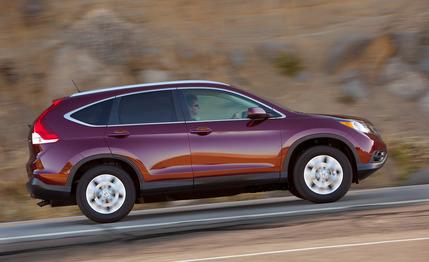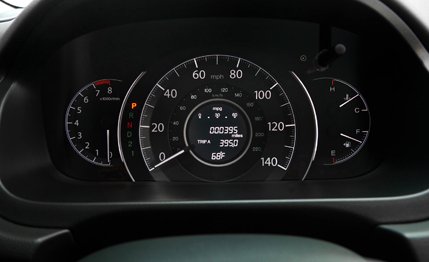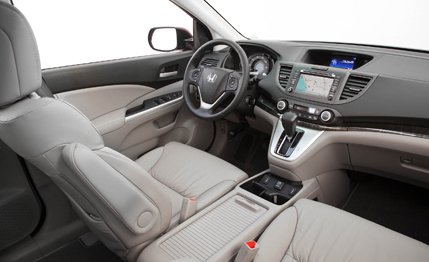
 Instrumented Test
Instrumented Test


Compact crossovers are a little like toothbrushes. They perform a necessary function, but they’re rarely exciting. Everybody needs a toothbrush, though, and toothbrush manufacturers want to outsell their competitors, so we have wear-indicating bristles, flexible split heads, integrated tongue-and-cheek scrapers, and the like.
Accordingly, much of Honda’s technical presentation on the new CR-V focused on the next-gen mini-ute’s new features, including standard stuff like two info screens, a rearview camera, Bluetooth, and a function that reads incoming text messages from paired phones—assuming said phone is from a short list of BlackBerrys or a Droid X, as those are the only devices with which the CR-V can currently communicate. Meanwhile, lesser points like the powertrain and the basic construction of the chassis were only mentioned in passing. Makes sense: Once Colgate nails down the perfect handle cross section, head shape, and bristle feel, it’s probably going to keep making that same toothbrush. Honda was pretty happy with the outgoing CR-V—and its sales numbers indicated that buyers were, too—so the new CR-V is a lot like the old one.
Hello, Again. You Should Have Brought a Friend. Maybe a Turbo.
The spec-sheet familiarity begins with the only available engine. It’s the same dual-overhead-cam 2.4-liter inline-four, but it now boasts a 5.4-percent reduction in internal friction and a more efficient alternator. These slight changes increase output to 185 hp and 163 lb-ft, bumps of five and two. It’s worth noting that the power peak occurs at 7000 rpm, and the automatic transmission shifts about 300 or so rpm before that. Unless you’re going to lock your CR-V in first around town, don’t expect to feel those extra fillies. You won’t hear them quite as much as before, either, although Honda still has the most pleasing soundtrack in the tiny-truck business. It’s louder than we would expect most crossover buyers to want, but it obviously isn’t deterring many—the CR-V is the perennial bestseller in its segment.


Behind that only slightly updated engine is an only slightly updated transmission. Against a market that is swelling with six-speed automatics—not to mention the nine-speed ZF unit on its way for front-drive applications—Honda is sticking with the CR-V’s fiver. Lower-friction internals and lower-viscosity transmission fluid boost efficiency, and a wider ratio spread nudges the CR-V’s fuel-economy ratings up. Front-drivers increase their mileage from 21/28 city/highway to 23/31; all-wheel-drive models go from 21/27 to 22/30.
The Snow Falls and Molasses Wins
The downside is that the CR-V remains among the slowest in its class. The Honda’s ratios make it feel even slower than its predecessor—in first gear, redline resides north of 40 mph; in second, it’s hiding in the 80-mph range—but when we got the new CR-V to the test track, it actually clicked off the 0-to-60 run 0.2 second quicker, or 8.5 seconds. We’ve recently logged about half-a-dozen complaints about the ratio spread in Chrysler’s rear-drive five-speed—we would like Honda to note that this unit is imminently being replaced with an eight-cogger—because of its ludicrous gearing.


Although few people floor it off the line during their morning commute (more people should try it; they’d be amazed how much more time they have in a day if they don’t drive like they’re dead or waiting to be), there are real-world drawbacks to dog-slow crossovers. Run up on a surprisingly slow truck on the freeway, and you’d better have a long opening behind you in the left lane. When you pop out to pass and give the CR-V the boot, it’s going to need a lot of time to get up to speed. Accelerating from 50 to 70 mph takes 5.6 seconds, and the combined time for 30-to-50 and 50-to-70 runs is more than 10 seconds. Should you floor it at much more than 60 mph, the trans only drops into third, stranding you around 3500 rpm. At that speed, it feels like you only need two digits to quantify the 2.4-liter’s torque output. Drivers behind you are likely to display two digits of their own. For even greater sluggishness, Honda fits all 2012 CR-Vs with an “econ” button that dulls throttle response and widens the acceptable window of variation for the cruise and climate controls.
In response to criticism for sticking with the five-speed, Honda’s answer was along the lines of, “Our five is damn good. The customers wanted efficiency gains—we gave them efficiency gains.” We appreciate the philosophy of extracting greater efficiencies from existing hardware before creating all-new systems, but clinging to the five-speed seems kind of lazy.